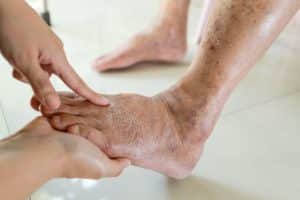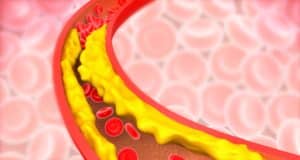Peripheral Arterial Disease (PAD) – Diagnosis, Prevention and Treatment
What is Peripheral arterial disease (PAD)?

People with Diabetes are at higher risk of developing atherosclerosis, the most common cause of peripheral artery disease (PAD). Elevated blood sugar levels can impact artery walls. This may lead to an accumulation of cholesterol plaque in these arteries which may impact blood flow. This decrease in blood flow affects the ability of oxygen and nutrients to reach the tissues, placing them at risk for damage and delayed healing. Smoking, high blood pressure and obesity are common contributors to the increased prevalence of peripheral arterial occlusive disease in diabetics.
What is the relationship between PAD and diabetic foot ulcers?
Peripheral arterial disease accounts for up to 50% of diabetic foot ulcers and acts as an independent risk factor for their development. There is a higher prevalence of PAD in diabetic patients, with up to 11% of diabetic patients being affected when compared to 4% of non-diabetics. ¹
Peripheral artery disease and Diabetes place individuals at high risk for wound healing compromise and potential amputation. The negative synergistic effect of these diseases increases the complexity of wound healing more than these diseases individually.
How can peripheral arterial disease be prevented?

Peripheral arterial disease is one of the factors linked to diabetic foot ulcers in patients with diabetes, which stresses the importance of early treatment of vascular disease. Knowing these factors underscores the need for other preventative measures as well. Diabetic patients need to examine their feet daily (or have some do this for them), and see their health care professional routinely to assess for the presence of peripheral artery disease, the status of their diabetes management, and to perform a detailed lower extremity assessment.
What are the goals of treating peripheral arterial disease?

The health care professional will assist in providing the best education and tools for blood sugar and cholesterol level management, and other required testing and treatment. The overall goal is improving blood flow, treatment of vascular risk factors, management of diabetes and comorbid conditions. An overall treatment plan may also include guidelines for nutrition and exercise. Stopping smoking, losing weight if needed, and taking prescribed medicines as ordered is paramount.
How can daily foot hygiene and examination reduce the role of PAD?
Most important to foot ulcer prevention is daily foot examination and care. Your health care professional will instruct you on:
Best practices for daily foot inspection.
This may include checking for cuts, blisters, redness, swelling or nail problems. Use a magnifying hand mirror to look at the bottom of your feet, and call your doctor if you notice anything.
Daily foot hygiene.
Keeping the feet clean by washing them daily using lukewarm, never hot, water. Be gentle when bathing your feet. Wash them using a soft washcloth or sponge. Dry by blotting or patting and carefully dry between the toes. Wear clean, dry socks and change them daily. Consider using an antiperspirant on the soles of your feet. This is helpful if you have excessive sweating of the feet.
Addressing dry skin and preventing fissures.
Use a moisturizer daily to keep dry skin from itching or cracking, but don’t moisturize between the toes—that could encourage a fungal infection.
Proper nail care.
Cut nails carefully, straight across and file the edges. Don’t cut nails too short, as this could lead to ingrown toenails. You health care professional may request that your nail care be performed by a specialty physician such as a podiatrist.
Prevent tissue injury.
Never treat corns or calluses yourself. No “bathroom surgery” or medicated pads. Visit your doctor for appropriate treatment. Always shake out your shoes and feel the inside before wearing. Remember, your feet may not be able to feel a pebble or other foreign object, so always inspect your shoes before putting them on. Never walk barefoot. Not even at home. Always wear shoes or slippers. You could step on something and get a scratch or cut. If you have cold feet, wear socks to bed. Never use a heating pad or a hot water bottle to keep your feet warm.
If you develop an injury, see your health care professional immediately for appropriate treatment. Although diabetics with peripheral artery disease and ulceration have a high risk of adverse outcomes, these outcomes are improving thanks to recent advances in pharmacology, medical devices and procedural techniques.
To learn more about Sanara MedTech products, please visit. https://sanaramedtech.com/surgical/
1 Brownrigg JR, Schaper NC, Hinchliffe RJ. Diagnosis and assessment of peripheral arterial disease in the diabetic foot. Diabetic Med. 2015;32:738–747




